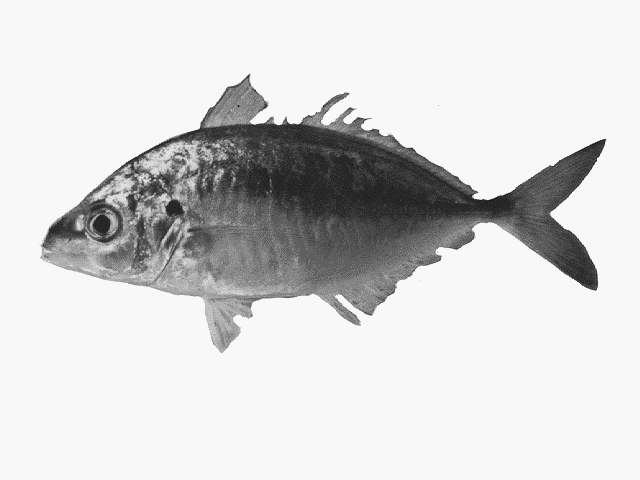Pseudocaranx
wrighti
(Whitley,
1931)
Skipjack trevally
View all media / Upload your photos and videos
Expand all
Classification / Names
Teleostei (teleosts) > Carangiformes (Jacks) >
Carangidae (Jacks and pompanos)
> Caranginae
Etymology: Pseudocaranx: Greek, pseudes = false + French, carangue, the name of a Caribbean fish; 1836 (Ref. 45335).
More on author:
Whitley.
Environment / milieu / depth range / climate zone / distribution range
Marine; brackish; pelagic-neritic; depth range ? - 30 m (Ref. 33616); temperate.
Distribution
Eastern Indian Ocean: southern Australia, from Western Australia to New South Wales.
Maps

Pseudocaranx wrighti / Native range
AquaMaps Data sources:
GBIF
OBIS
This map was computer-generated and has not yet been reviewed.

Pseudocaranx wrighti / Suitable habitat
AquaMaps Data sources:
GBIF
OBIS
This map was computer-generated and has not yet been reviewed.

Pseudocaranx wrighti / Point map
AquaMaps Data sources:
GBIF
OBIS
This map was computer-generated and has not yet been reviewed.

Pseudocaranx wrighti / Year 2050
AquaMaps Data sources:
GBIF
OBIS
This map was computer-generated and has not yet been reviewed.
Size / Weight / Age
Max length: 70.0 cm SL male/unsexed (Ref. 9563).
Short description
Dorsal spines (total): 9; Dorsal soft rays (total): 22 - 26; Anal spines: 3; Anal soft rays: 18 - 22; Vertebrae: 24. This species is distinguished by the following characters: posterior margin of upper jaw canted posteroventrally; the lachrymal and expanded part of the maxilla densely covered with scales; a well-defined opercular spot, nearly solid black and approximately the diameter of the pupil; caudal vertebra 14; gill rakers, upper 10-15, lower 24-28, total 35-43; lateral line with 37-48 scales in the curved portion and 24-35 posterior scutes; never developing a yellow mid-lateral body stripe; second dorsal and anal fins transparent or dusky green, no yellow pigmentation. (Ref. 76781).
Biology
Main reference
Paxton, J.R., D.F. Hoese, G.R. Allen and J.E. Hanley 1989 Pisces. Petromyzontidae to Carangidae. Zoological Catalogue of Australia, Vol. 7. Australian Government Publishing Service, Canberra, 665 p. (Ref. 7300)
IUCN Red List Status (Ref. 125652)
Least Concern (LC); date assessed: July 19 2017
CITES (Ref. 123416)
Not Evaluated
CMS (Ref. 116361)
Not Evaluated
Threat to humans
Harmless
More information
- Countries
- FAO areas
- Ecosystems
- Occurrences
- Introductions
- Stocks
- Ecology
- Diet
- Food items
- Food consumption
- Ration
- Common names
- Synonyms
- Metabolism
- Predators
- Ecotoxicology
- Reproduction
- Maturity
- Spawning
- Spawning aggregation
- Fecundity
- Eggs
- Egg development
- Age/Size
- Growth
- Length-weight
- Length-length
- Length-frequencies
- Morphometrics
- Morphology
- Larvae
- Larval dynamics
- Recruitment
- Abundance
- References
- Aquaculture
- Aquaculture profile
- Strains
- Genetics
- Allele frequencies
- Heritability
- Diseases
- Processing
- Mass conversion
- Vision
- Pictures
- Stamps, Coins Misc.
- Sounds
- Ciguatera
- Speed
- Swim. type
- Gill area
- Otoliths
- Brains
Estimates based on models
Preferred temperature (Ref. 123201): 16.1 - 22.8, mean 18 °C (based on 172 cells).
Phylogenetic diversity index (Ref. 82804): PD50 = 0.5625 [Uniqueness, from 0.5 = low to 2.0 = high].
Bayesian length-weight: a=0.01349 (0.00646 - 0.02815), b=2.96 (2.79 - 3.13), in cm total length, based on LWR estimates for this (Sub)family-body shape (Ref. 93245).
Trophic level (Ref. 69278): 3.4 ±0.3 se; Based on diet studies.
Resilience (Ref. 120179): Medium, minimum population doubling time 1.4 - 4.4 years (Preliminary K or Fecundity.).
Fishing vulnerability (Ref. 59153): Moderate to high vulnerability (54 of 100).
Price category (Ref. 80766): Medium; Very questionable: based on ex-vessel price for species in this family.
Nutrients (Ref. 124155): Calcium = 39 [19, 93] mg/100g; Iron = 0.518 [0.278, 1.036] mg/100g; Protein = 19.7 [18.5, 21.0] %; Omega3 = 0.612 [0.332, 1.186] g/100g; Selenium = 8.61 [3.98, 18.59] μg/100g; VitaminA = 9.84 [2.68, 35.36] μg/100g; Zinc = 0.663 [0.453, 0.947] mg/100g (wet weight);


